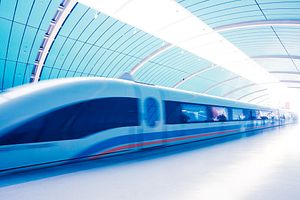In a speech given in front of the New York Stock Exchange, Japanese Prime Minister Shinzo Abe in late September pitched the use of Japanese maglev train technology to connect New York and Washington with a high-speed train capable of roughly 300 mph (480 km/h). This would double the speed of the current fastest rail line on the northeast corridor, and reduce travel time between the two cities to an hour. Both Abe and the U.S. company hoping to bring the new technology to America, The Northeast Maglev (TNEM), say the new train will reduce automobile and airplane emissions by drawing traffic to the much more efficient high-speed rail line. It will also be faster than flying between New York and D.C., especially when airport check-in times are factored in.
Japan has plans to build its own new high-speed maglev line between Toyko, Nagoya, and Osaka. The segment between Tokyo and Nagoya is expected to be ready by 2027, with Osaka being connected by 2045 at an overall cost of $100 billion. However, the new line is not without its critics at home. For one thing, it will be built parallel to the existing high-speed Shinkansen line. According to Reijiro Hashiyama, visiting professor at Chiba University of Commerce, parallel high-speed train systems which effectively double capacity are not cost effective in a country with a shrinking population. The Central Japan Railway Company says it plans to increase profit and offset cost by drawing more customers from both the airline and automobile industry.
JR Central claims a trip from Tokyo to Osaka will take half the time and only cost 1000 yen (roughly $10) more. This makes the critique of whether or not the new line will be popular enough to pay for and justify itself almost moot. Even with a shrinking population, a much higher percentage of passengers could be expected to pay a modestly higher fare for such a dramatic drop in travel time. Given that the existing high-speed rail lines will be undergoing major renovations at the same time, the new maglev system may actually be a necessity.
Can this technology be successfully exported to the U.S.? From Japan’s standpoint it is almost an imperative. Staying at the forefront of new technologies is what kept the Japanese economy in overdrive during the late 20th century, for instance with the export of nuclear power and high-speed rail expertise. Being the first country to install and export Maglev technology would be a boon, especially as other traditional growth industries, like consumer electronics and automobiles, slow down or lose their competitive edge.
For America the question is different. The mass transit infrastructure on the East Coast is in bad need of an upgrade. Amtrak’s existing high-speed train Acela can in theory travel at half the speed of the envisioned Maglev system, yet currently it runs much slower. Japan’s partner in this project, TNEM, has an advisory board chock full of former U.S. transportation secretaries and ex-governors from New York, Pennsylvania and New Jersey, along with former Senate majority leader Tom Daschle (D-SD). Consequently the lobbying power behind the group should be rather formidable.
However, the ability to push expensive, high-end infrastructure through Congress is tough even at the best of times. It may also be difficult to make such costly infrastructure profitable in the Northeast Corridor, where population density doesn’t compare to that along Japan’s proposed maglev line. Without an overall cost estimate for the entire New York-Washinton D.C. line however, the profitability comparison may not be pertinent. 40 percent of the envisioned Japanese line will supposedly be drilled through its mountainous coastline. The heavy initial outlay this entails will likely not be a factor for the U.S.
Northeast Maglev claims it will be able to fund the project through a mix of private investors and public sources. The Abe government has offered to provide key components free of charge for the initial section connecting Washington D.C. and Baltimore, as well as loans to finance up to half of this portion’s $8 billion estimated cost. This will be enticing, and may be sufficient to build an initial showcase of the technology that could be expanded on if deemed a success.
For the U.S., this will come down to the right mix of public, private and foreign investment combined with an administration and Congress that are willing to expend the necessary political capital on such a project. Building the line in segments that connect the major cities and their airports is probably the most feasible approach. If the trip from Baltimore to Washington D.C. can be reduced to 15 minutes and successfully connect with existing public transportation in both cities, a problem not taken into account with China’s unpopular maglev train in Shanghai, then the initial segment could be an easy and popular first step.
For Abe, successfully exporting maglev technology to a prime Western market would not only be a political victory; it would show investors in the new Tokyo/Nagoya/Osaka line that the technology can be profitable outside Japan, where profit won’t be seen for decades after the line is built. The ability to take a technology beyond the domestic market is one of the cornerstones of the Japanese economy. Locating those foreign markets and providing the right incentives to places in need of either an upgrade or entry into high-speed rail will be the first challenge Japan faces.

































